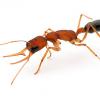https://www.youtube....h?v=7k4Hvtdhegw
Watch 7:20 to 7:35. Is this good advice?
If the link doesn't work, this is what he said:
"Personally, I would not hibernate these ants (Myrmica rubra) as they don't really have a very developed biological clock, I find. And they don't really need the hibernation process to achieve anything at all. They can just keep growing through the winter."
In any case, would this apply to North American species of Myrmica as well?
















